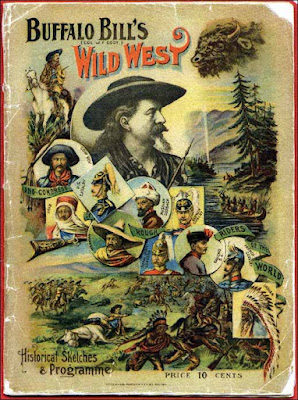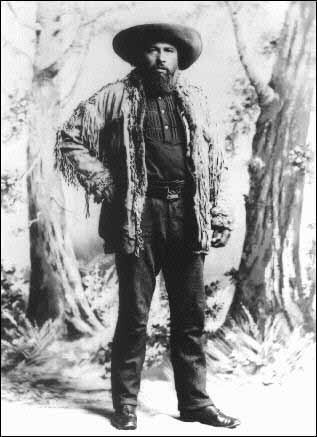 Gabriel Dumont, Metis leader, was born in the Red River Settlement in December, 1837. According to this biography, Gabriel married a Pembina* Girl in 1858, named Madeleine Wilkie.**
Gabriel Dumont, Metis leader, was born in the Red River Settlement in December, 1837. According to this biography, Gabriel married a Pembina* Girl in 1858, named Madeleine Wilkie.** As a young man he became an expert horseman, accurate with both bow and rifle. In the summer of 1863, still a young man of 25, he was elected permanent chief of the annual Metis buffalo hunt***, and led his people until the virtual extermination of the buffalo in 1881.
 When bison disappeared and white settlers began to settle the prairies, Dumont recognized that the Metis way of life was changing. He led the campaign for recognition of Metis rights in the Northwest and, when it became evident that the campaign would be unsuccessful, called upon Louis Riel to assist the Metis in their fight. During the North-West Rebellion, Dumont was admired and feared for his abilities as a guerrilla leader of the Metis and native forces.
When bison disappeared and white settlers began to settle the prairies, Dumont recognized that the Metis way of life was changing. He led the campaign for recognition of Metis rights in the Northwest and, when it became evident that the campaign would be unsuccessful, called upon Louis Riel to assist the Metis in their fight. During the North-West Rebellion, Dumont was admired and feared for his abilities as a guerrilla leader of the Metis and native forces.  After Riel's surrender, Dumont fled to the United States and joined Buffalo Bill's Wild West Show as a marksman. On February 19, 1889, Dumont was pardoned for his role in the rebellion, and returned to Batoche. He died of heart failure in 1906.
After Riel's surrender, Dumont fled to the United States and joined Buffalo Bill's Wild West Show as a marksman. On February 19, 1889, Dumont was pardoned for his role in the rebellion, and returned to Batoche. He died of heart failure in 1906.* From the Manitoba Metis Federation website comes this interesting information regarding Metis history in Pembina: The town of Pembina, located on the Red River just south of the 49 th parallel is the former heart of the Metis territory. Once the border was drawn at the 49 th parallel and it was found that Pembina was in the United States and not in Canada many of the Metis migrated north to St. Boniface, St. Vital, St. François Xavier and Fond du Lac (now St. Laurent). The first fur trading post was established at Pembina in 1797. This community evolved over the years from a fur trade site to colony, river town, shipping centre, military outpost, and scene of international disputes. Pembina was a primarily Métis town. It hosted missionaries and explorers; it was also a staging centre for surveyors moving west. In 1818, Father Sevine Dumoulin established a mission (St. François Xavior) at Pembina to serve the Metis and Chippewa Catholic converts. In the winter, almost the entire population of Red River would move south to Pembina to winter there, thus avoiding the harsher climate at the forks. At its peak of activity, it had over 500 residents and 40 permanent buildings. Pembina was an important centre for the buffalo hunt and important as a stopping point for the Red river cart trains between St. Paul, Minnesota and Fort Garry. Before the borders of North Dakota were established, Pembina was part of the Minnesota Territory. The famous Joe Roulette was sent to the legislative assembly in St. Paul in 1853 to represent this district on the Territorial Council. He served from 1853 to 1857. At the time the Metis population in Pembina was about 5,000, roughly equal to the Metis population in British controlled Rupert’s Land.
** Madeleine was the daughter of "...Jean Baptiste Wilkie, Metis b-1803 Pembina a hunter married Amable Elise Azure, Metis b-1808 Pembina"; her father was a well-known local leader of the Pembina Metis - "...Jean Baptiste Wilkie of the Pembina party represented the buffalo hunt this year [1851]"
*** Métis buffalo hunts were of colossal size. In 1865, Alexander Ross, a settler in Red River, reported in detail on an expedition which left the Red River Settlement on June 15, 1840. When the roll was called at Pembina, 1, 630 people were present with 1, 210 Red River carts. In 1854, Pére Belcourt reported that there were about 2, 000 Métis living at Pembina. When these people joined others from the Assiniboia District they would mount hunting expeditions with as many as 5,000 Métis and Indians. These parties traveled an extensive route, some as far as the Missouri River to just below Fort Mandan.
[Source: Louis Riel Institute]
No comments:
Post a Comment